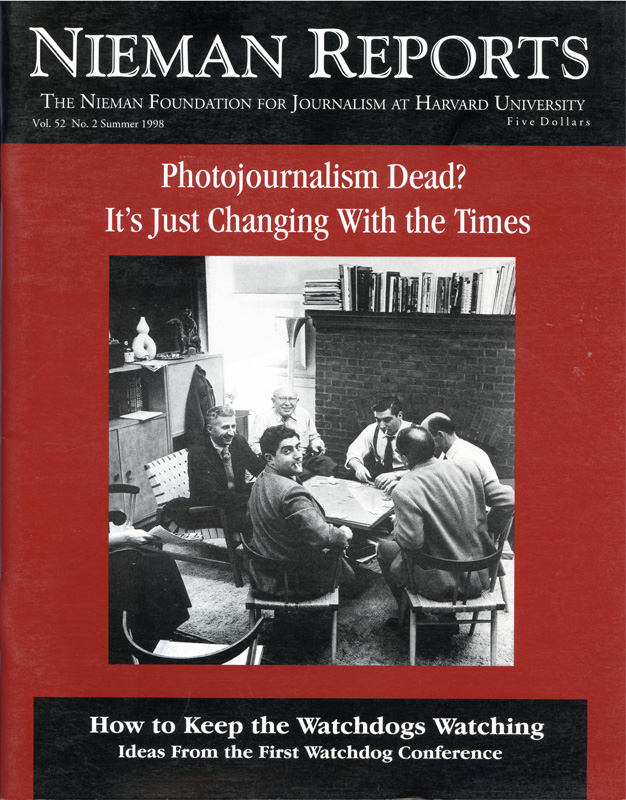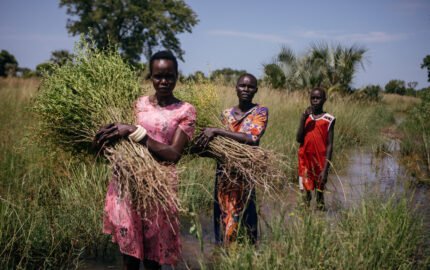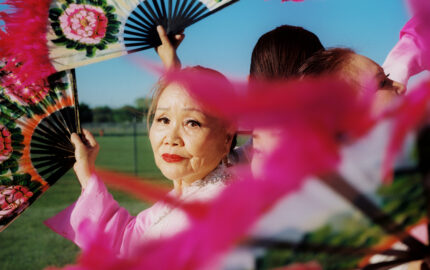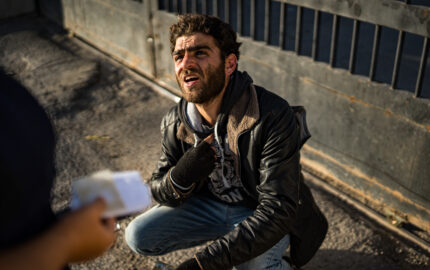
Photojournalism Dead? It's Just Changing With the Times
In the next 50 pages Nieman Reports take stock of photojournalism today. While problems are noted, the report is positive. The articles and the photo essays by 10 Nieman Fellows demonstrate the special value of pictures to news. As noted photographer Edward Steichen summed it up at the dinner celebrating his 90th birthday in 1969: “The mission of photography is to explain man to man and each man to himself. And that is no mean function.”
Pinned to my office door is a poster prepared by one of my students, a peer adviser who uses it to help orient incoming freshmen. On it she quotes documentary photographer Dorothea Lange: “A camera is an instrument that teaches you how to see without the use of a camera.”
Lange hung on her own door a quotation by Francis Bacon: “The contemplation of things as they are without error or confusion is in itself a nobler thing than a whole harvest of invention.”
These two gems of wisdom make fine touchstones for anyone who would practice, as well as teach, photojournalism. Discipline yourself to see with or without a camera by immersing yourself in life and drawing inspiration from its diversity.
My objective as a teacher is to tap the wisdom within my students in ways that inspire them to resonate with the larger world. I believe that each of us has a wellspring of creativity that resides in our unique set of family, cultural and educational experiences and values. Students will progress faster and further if they can relate what they already know to the experiences and concerns of others. Above all I try to discourage imitation, a practice that can produce quick competence but lead to formulaic and stereotypical thinking.
That emphasis on resonating with the outer world is a key factor in separating the best from run-of-the-mill after students become professional photographers.
I demonstrate processes that apply to all problems rather than narrow solutions that apply only to specific problems. By teaching ways of thinking, instead of what to think, I encourage my students to become self-teachers, to adopt habits of gathering and processing information that provide a foundation for a lifetime of self-renewal.
I prefer to coach rather than to lecture, to engage students in dialogues that amplify the insights of individuals to inform and inspire the group. I insist that the tone of critiques be positive and frame them with two questions: What is strong about this work? What would make it better?
As students debate specific details I moderate to bring out as many voices as possible. I point out broad themes and show how photographers have handled similar situations in different ways, or the same situation in different ways. I summarize by linking key points to ideas expressed in lectures and readings and conclude by suggesting how lessons learned in critique can be applied to future assignments.
When I lecture I try to frame concepts within a historical, philosophical and ethical perspective. For instance, an understanding of digital technology requires an awareness of the professional and cultural influences of all reproduction technologies from the daguerreotype through wet plates, roll films, miniature cameras, offset printing and so forth. Concurrently one must understand how image manipulation has been both celebrated and maligned throughout the history of the photographic processes.
Like Lange, I believe that photojournalism’s principal mission is to show people doing the things that make them newsworthy, to show the impact of issues on people’s lives.
This requires thorough, painstaking research—a chore that some photographers seek to avoid, or to pass on to others. One must understand a subject’s character, habits and circumstances well enough to anticipate opportunities for making meaningful pictures.
As in all fields of journalism, the wider one’s base of knowledge, the more likely one is to recognize good stories and good subjects. That’s why a broad liberal arts education is required by all accredited schools of journalism.
Still, nothing can substitute for personal experience. I demand that students get off campus into the wider world to complete assignments as often as possible.
Individuality: the source of photographic “freshness”
The authority and appeal of documentary pictures are derived from the vitality and relevance of a particular situation. Originality must flow from the subject as well as the photographer. The primary act of seeing is recognizing possibilities.
Year after year in the Pictures of the Year contest thousands of images appear that have a sameness and predictability. Many are well composed and technically perfect, but the people in them resemble characters from central casting; the scenes, an episode from a TV drama or sitcom. The photographer has emphasized topic and technique instead of prospecting for that special circumstance.
A great story demands patience. Take time to get acquainted; your subject needs to size you up as much as you do him. Be honest, be open, be persistent. Immersion projects will take you through three levels of awareness: first, the superficial images that any good photographer would see; second, the less obvious photo opportunities that are revealed by interviews and careful observation, and, third, the insightful and often sobering revelations that come only with extreme intimacy.
The teaching process starts with the first interview.
I begin by telling students how I think their skills, interests and experiences compare with those of other students and professionals. I encourage them to visualize the stages through which each will pass as he or she learns to make pictures that are more informative and appealing.
I challenge them to imagine an unbroken continuum that will take them from where they are to where they want to be, to view their education as a series of many small steps, not a few giant leaps. This makes the prospect of becoming a professional less daunting.
From the start I insist that they think of themselves as professionals. Unlike medical students who practice on laboratory animals or cadavers, photojournalism students work with real, live people. Thus, they must soon learn to respect the privacy of others and to appreciate how having one’s picture published can alter his or her life.
RELATED ARTICLE
"Pictures Dominate, Words Come Second"
- Sherry JonesUnlike writers who can disguise a source’s identity, photographers reveal their subjects’ lives in brilliant, often harsh, detail. The more sensitive the topic, the more important it is that photographers educate their subjects about the possible consequences of being in the newspaper. The relationship between subject and photographer is much more collaborative than that of source and writer.
Once photos of sensitive issues have been made, the photographer must see that accurate context is maintained. This means paying attention to captions and headlines and working closely with editors and layout artists to avoid misrepresentation.
If one is not on staff but sells through an agent, the challenge is even greater. Pittsburgh freelance Lynn Johnson says that she keeps certain negatives under lock and key to minimize the chance that they will be misused.
I urge students to begin building portfolios as soon as possible to track their own development; to provide a focal point for constructive criticism by teachers and professionals, and to document their skills and accomplishments when applying for employment.
I also encourage them to seek out work experiences that can sharpen their skills and build confidence and personal references. Even a beginner can market himself if he is imaginative and willing to work hard. In today’s highly competitive newspaper industry few graduates can qualify for an entry level position without at least one or two successful internships.
At the core of photojournalism education are practical exercises that introduce the fundamental reporting and editing challenges that face all professionals. Purely technical exercises should be avoided.
RELATED ARTICLE
"Honest Emotion"
- Torsten KjellstrandAn example: since photojournalists often must show how people are affected by events and issues, an early assignment is to “photograph an honest, candid emotion.” This forces the student to explore how facial expression, gestures and body language convey mood and personality, which establishes a framework for thinking about candid portraiture that will serve throughout their careers. This exercise was suggested by Minneapolis Tribune photojournalist Mike Zerby, who has taught part-time at several Twin Cities colleges and universities for nearly 30 years.
RELATED ARTICLE
"Interaction"
- Mary Beth MeehanA variation on this theme is to: “Show in a photograph the relationship between two or more people.” This takes the “honest emotion” assignment a step further and requires the student to explore human interactions, one-on-one and in groups. This builds on the previous assignment, but the challenge is greater because there are many more variables.
Successive assignments challenge students to focus on specific topic areas, such as the coverage of team sports or news events, and add layers of information by integrating elements of the environment such as home and work settings, atmospheric conditions and natural lighting.
Whenever an exercise is used to introduce a specific technique it always is framed within the context of a reporting objective. For instance: off-camera bounce or direct flash is taught by assigning coverage of an event at night or in a dimly lit interior. Artificial lighting must be used well, but content is of equal importance.
RELATED ARTICLE
"People Without People"
- Alan BernerA favorite assignment borrowed from my own mentor, Dr. R. Smith Schuneman of the University of Minnesota, is “Show people without people: Make a photograph that reveals the presence of an individual without showing the person.” This challenges the student to observe how others shape the spaces where they live and work.
Learning to talk and write persuasively about pictures is the key to making and editing pictures well. This also develops the ability to persuade the writers, editors and page designers whose cooperation is essential to the success of every photojournalistic enterprise.
This begins with oral critiques and written self-analyses that are required with every assignment.
Photographers learn decision-making by describing what makes one photograph more effective than another. Criteria include news value, aesthetics, cultural sensitivity and technical quality.
Photos of people experiencing strong emotions can survive technical or compositional imperfections: readers will empathize with another’s joy or pain even if an image is grainy or blurred. However, scenes that lack human interaction—pictorials, landscapes and still lives, for instance—inspire emotions by appealing to the intellect. Craftsmanship and artistry are essential.
At the same time, as others have observed, the photograph that is a window to reality also is a mirror that reveals the biases of the image-maker. Thus, photographers must continually review their assumptions by inviting criticisms from third parties and reexamining their personal “truths.” What seems obvious to one person may seem obscure, irrelevant or mistaken to another.
The modern photojournalist must be a versatile and adaptable creature full of curiosity and enthusiasm for life. He or she must have an instinct for pictures and take joy in making and showing them to others. Respect for all who come before the camera is essential; no image should be so important that one would sacrifice his or her self-respect to get it.
Finally, appreciation of fellow photographers, writers, editors and designers and a willingness to share the creative process is essential if one hopes to thrive professionally in the coming century.
 Bill Kuykendall has directed the Missouri School of Journalism photojournalism sequence and the MU-National Press Photographers Association Pictures Of The Year competition for 12 years. He also codirects the Missouri Photojournalism Workshop, a mid-career educational program for photojournalists. He has served as Photo Director of The Seattle Times, Photo Editor of The Worthington Daily Globe and as a freelance photographer, designer and consultant. His honors include the NPPA Robin F. Garland Teacher of the Year award.
Bill Kuykendall has directed the Missouri School of Journalism photojournalism sequence and the MU-National Press Photographers Association Pictures Of The Year competition for 12 years. He also codirects the Missouri Photojournalism Workshop, a mid-career educational program for photojournalists. He has served as Photo Director of The Seattle Times, Photo Editor of The Worthington Daily Globe and as a freelance photographer, designer and consultant. His honors include the NPPA Robin F. Garland Teacher of the Year award.
Lange hung on her own door a quotation by Francis Bacon: “The contemplation of things as they are without error or confusion is in itself a nobler thing than a whole harvest of invention.”
These two gems of wisdom make fine touchstones for anyone who would practice, as well as teach, photojournalism. Discipline yourself to see with or without a camera by immersing yourself in life and drawing inspiration from its diversity.
My objective as a teacher is to tap the wisdom within my students in ways that inspire them to resonate with the larger world. I believe that each of us has a wellspring of creativity that resides in our unique set of family, cultural and educational experiences and values. Students will progress faster and further if they can relate what they already know to the experiences and concerns of others. Above all I try to discourage imitation, a practice that can produce quick competence but lead to formulaic and stereotypical thinking.
That emphasis on resonating with the outer world is a key factor in separating the best from run-of-the-mill after students become professional photographers.
I demonstrate processes that apply to all problems rather than narrow solutions that apply only to specific problems. By teaching ways of thinking, instead of what to think, I encourage my students to become self-teachers, to adopt habits of gathering and processing information that provide a foundation for a lifetime of self-renewal.
I prefer to coach rather than to lecture, to engage students in dialogues that amplify the insights of individuals to inform and inspire the group. I insist that the tone of critiques be positive and frame them with two questions: What is strong about this work? What would make it better?
As students debate specific details I moderate to bring out as many voices as possible. I point out broad themes and show how photographers have handled similar situations in different ways, or the same situation in different ways. I summarize by linking key points to ideas expressed in lectures and readings and conclude by suggesting how lessons learned in critique can be applied to future assignments.
When I lecture I try to frame concepts within a historical, philosophical and ethical perspective. For instance, an understanding of digital technology requires an awareness of the professional and cultural influences of all reproduction technologies from the daguerreotype through wet plates, roll films, miniature cameras, offset printing and so forth. Concurrently one must understand how image manipulation has been both celebrated and maligned throughout the history of the photographic processes.
Like Lange, I believe that photojournalism’s principal mission is to show people doing the things that make them newsworthy, to show the impact of issues on people’s lives.
This requires thorough, painstaking research—a chore that some photographers seek to avoid, or to pass on to others. One must understand a subject’s character, habits and circumstances well enough to anticipate opportunities for making meaningful pictures.
As in all fields of journalism, the wider one’s base of knowledge, the more likely one is to recognize good stories and good subjects. That’s why a broad liberal arts education is required by all accredited schools of journalism.
Still, nothing can substitute for personal experience. I demand that students get off campus into the wider world to complete assignments as often as possible.
Individuality: the source of photographic “freshness”
The authority and appeal of documentary pictures are derived from the vitality and relevance of a particular situation. Originality must flow from the subject as well as the photographer. The primary act of seeing is recognizing possibilities.
Year after year in the Pictures of the Year contest thousands of images appear that have a sameness and predictability. Many are well composed and technically perfect, but the people in them resemble characters from central casting; the scenes, an episode from a TV drama or sitcom. The photographer has emphasized topic and technique instead of prospecting for that special circumstance.
A great story demands patience. Take time to get acquainted; your subject needs to size you up as much as you do him. Be honest, be open, be persistent. Immersion projects will take you through three levels of awareness: first, the superficial images that any good photographer would see; second, the less obvious photo opportunities that are revealed by interviews and careful observation, and, third, the insightful and often sobering revelations that come only with extreme intimacy.
The teaching process starts with the first interview.
I begin by telling students how I think their skills, interests and experiences compare with those of other students and professionals. I encourage them to visualize the stages through which each will pass as he or she learns to make pictures that are more informative and appealing.
I challenge them to imagine an unbroken continuum that will take them from where they are to where they want to be, to view their education as a series of many small steps, not a few giant leaps. This makes the prospect of becoming a professional less daunting.
From the start I insist that they think of themselves as professionals. Unlike medical students who practice on laboratory animals or cadavers, photojournalism students work with real, live people. Thus, they must soon learn to respect the privacy of others and to appreciate how having one’s picture published can alter his or her life.
RELATED ARTICLE
"Pictures Dominate, Words Come Second"
- Sherry JonesUnlike writers who can disguise a source’s identity, photographers reveal their subjects’ lives in brilliant, often harsh, detail. The more sensitive the topic, the more important it is that photographers educate their subjects about the possible consequences of being in the newspaper. The relationship between subject and photographer is much more collaborative than that of source and writer.
Once photos of sensitive issues have been made, the photographer must see that accurate context is maintained. This means paying attention to captions and headlines and working closely with editors and layout artists to avoid misrepresentation.
If one is not on staff but sells through an agent, the challenge is even greater. Pittsburgh freelance Lynn Johnson says that she keeps certain negatives under lock and key to minimize the chance that they will be misused.
I urge students to begin building portfolios as soon as possible to track their own development; to provide a focal point for constructive criticism by teachers and professionals, and to document their skills and accomplishments when applying for employment.
I also encourage them to seek out work experiences that can sharpen their skills and build confidence and personal references. Even a beginner can market himself if he is imaginative and willing to work hard. In today’s highly competitive newspaper industry few graduates can qualify for an entry level position without at least one or two successful internships.
At the core of photojournalism education are practical exercises that introduce the fundamental reporting and editing challenges that face all professionals. Purely technical exercises should be avoided.
RELATED ARTICLE
"Honest Emotion"
- Torsten KjellstrandAn example: since photojournalists often must show how people are affected by events and issues, an early assignment is to “photograph an honest, candid emotion.” This forces the student to explore how facial expression, gestures and body language convey mood and personality, which establishes a framework for thinking about candid portraiture that will serve throughout their careers. This exercise was suggested by Minneapolis Tribune photojournalist Mike Zerby, who has taught part-time at several Twin Cities colleges and universities for nearly 30 years.
RELATED ARTICLE
"Interaction"
- Mary Beth MeehanA variation on this theme is to: “Show in a photograph the relationship between two or more people.” This takes the “honest emotion” assignment a step further and requires the student to explore human interactions, one-on-one and in groups. This builds on the previous assignment, but the challenge is greater because there are many more variables.
Successive assignments challenge students to focus on specific topic areas, such as the coverage of team sports or news events, and add layers of information by integrating elements of the environment such as home and work settings, atmospheric conditions and natural lighting.
Whenever an exercise is used to introduce a specific technique it always is framed within the context of a reporting objective. For instance: off-camera bounce or direct flash is taught by assigning coverage of an event at night or in a dimly lit interior. Artificial lighting must be used well, but content is of equal importance.
RELATED ARTICLE
"People Without People"
- Alan BernerA favorite assignment borrowed from my own mentor, Dr. R. Smith Schuneman of the University of Minnesota, is “Show people without people: Make a photograph that reveals the presence of an individual without showing the person.” This challenges the student to observe how others shape the spaces where they live and work.
Learning to talk and write persuasively about pictures is the key to making and editing pictures well. This also develops the ability to persuade the writers, editors and page designers whose cooperation is essential to the success of every photojournalistic enterprise.
This begins with oral critiques and written self-analyses that are required with every assignment.
Photographers learn decision-making by describing what makes one photograph more effective than another. Criteria include news value, aesthetics, cultural sensitivity and technical quality.
Photos of people experiencing strong emotions can survive technical or compositional imperfections: readers will empathize with another’s joy or pain even if an image is grainy or blurred. However, scenes that lack human interaction—pictorials, landscapes and still lives, for instance—inspire emotions by appealing to the intellect. Craftsmanship and artistry are essential.
At the same time, as others have observed, the photograph that is a window to reality also is a mirror that reveals the biases of the image-maker. Thus, photographers must continually review their assumptions by inviting criticisms from third parties and reexamining their personal “truths.” What seems obvious to one person may seem obscure, irrelevant or mistaken to another.
The modern photojournalist must be a versatile and adaptable creature full of curiosity and enthusiasm for life. He or she must have an instinct for pictures and take joy in making and showing them to others. Respect for all who come before the camera is essential; no image should be so important that one would sacrifice his or her self-respect to get it.
Finally, appreciation of fellow photographers, writers, editors and designers and a willingness to share the creative process is essential if one hopes to thrive professionally in the coming century.
 Bill Kuykendall has directed the Missouri School of Journalism photojournalism sequence and the MU-National Press Photographers Association Pictures Of The Year competition for 12 years. He also codirects the Missouri Photojournalism Workshop, a mid-career educational program for photojournalists. He has served as Photo Director of The Seattle Times, Photo Editor of The Worthington Daily Globe and as a freelance photographer, designer and consultant. His honors include the NPPA Robin F. Garland Teacher of the Year award.
Bill Kuykendall has directed the Missouri School of Journalism photojournalism sequence and the MU-National Press Photographers Association Pictures Of The Year competition for 12 years. He also codirects the Missouri Photojournalism Workshop, a mid-career educational program for photojournalists. He has served as Photo Director of The Seattle Times, Photo Editor of The Worthington Daily Globe and as a freelance photographer, designer and consultant. His honors include the NPPA Robin F. Garland Teacher of the Year award.


